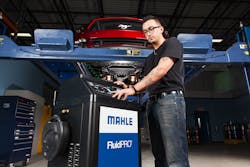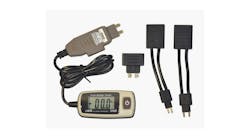Vehicles affected: All
Tools used:
- Vehicle information
- Battery/charging system tester
- Radiator pressure tester
- Fluid test strips
- Digital camera or smartphone camera
- Serpentine belt wear gauge
- WD-40 Rust Release
- Fluid exchange equipment
- Stretch belt remover/installer
- Broken spark plug remover
- Camshaft holding tools
Vehicles today may need less repairs due to better technology, but they still need maintenance services. Some of the challenges you may face in selling and performing maintenance could be convincing your customer why maintenance is necessary, and performing that maintenance in an efficient manner.
Because of YouTube and other online sources, many consumers are now better informed about what may be necessary maintenance and also may be misinformed as to what time and cost is involved to perform those services correctly.
Step 1: Review vehicle history
It is always critical to review the maintenance and repair history of the vehicle. This can be done by reviewing your records if the vehicle is a regular visitor to your shop. If not, it is a good idea to use your repair information resources to determine what services are recommended by the manufacturer for that specific mileage and/or time interval. You also should ask the vehicle owner if all of the previously recommended services were performed.
Recently there has been a movement within the automotive aftermarket to convince repair shops to resist using the term “recommend” when selling services to your customers unless that service is listed in the owner’s manual as being necessary at a specific time or mileage interval. Another term to avoid is “need,” as it could be interpreted by a customer as a requirement. The preferred terminology is now to “suggest” service based on a specific reason. Reasons could include that component life will be extended by performing a service, or due to contaminated fluid a more costly repair will be avoided by performing a maintenance. (More on fluid contamination later.) Changing how you sell has come about because a small number of shops “oversell” services building distrust between shops and the general public.
Another essential part of communication with your customer is understanding how they use their vehicle and which maintenance schedule they should be using. As you know, there is a “normal” and a “severe” service schedule for vehicles. Once you and your customer understand the definition of severe driving conditions, it becomes very easy to explain to them they are most likely driving under those conditions and should follow the schedule recommended for severe driving. We created a sign for our customer area listing the examples of severe service we used as a reference and could ask our customers if they drove under any of those conditions. We found this to be an effective way to communicate.
Using your vehicle information sources and sharing the maintenance schedule with a customer is also very useful. Identifix Direct-Hit has a very well-implemented maintenance portfolio which shows the maintenance schedule for normal and severe service, and also a specific schedule for vehicles built to meet California emissions requirements. Easily found within the maintenance schedules, recall and TSBs specific to the vehicle application are also available where you may find changes to factory service intervals or common issues to that vehicle.
Step 2: Inspect the vehicle
Using the maintenance schedule and vehicle history as a guideline, inspect the vehicle using industry best practice procedures such as the Motorist Assurance Program (MAP) guidelines or specific procedures your shop has developed. While inspecting the vehicle, use tools that are now available that can be used to show your customer specifically why a service is being suggested.
Tools that should be used include battery/charging system testers that are equipped with a printer so test results can be shared with the customer. Using either a code reader or a scan tool to check for codes, pending codes and monitor status also should be completed and the results printed to share with the customer. Remember, one of the reasons to sell maintenance is to prevent repairs and breakdowns.
When checking fluids, the level and condition is necessary to note prior to performing any service or recommending service. Fluid levels should be checked to determine if a leak may be present. Using a pressure tester to check the radiator cap and radiator is necessary when fluid levels are low, as well as after any service is performed, on the cooling system.
Test strips to check fluids such as brake fluid and coolant should be used to determine if fluids are degraded by contamination. Using these test strips allow the technician to accurately test and report the condition of the fluid by visually showing a “pass” or “fail” of the fluid condition. Brake fluid test strips show moisture, which can cause corrosion in the brake system and reduce the boiling point of the fluid, along with other contaminants such as copper and other metals, which can indicate component wear within the brake hydraulic system.
Coolant test strips are used to check the pH, alkalinity and freeze/boiling points of the coolant. Coolant fluid exchange services should be recommended if the pH or alkalinity is incorrect, which can cause excessive corrosion. Coolant may be added if the freeze/boiling points are too low, but the pH and alkalinity must meet requirements both before and after coolant is added. Recent improvements in test strip technology have made it possible to use one strip to test multiple fluids. These strips have a test for coolant on one end and a test for brake fluid on the other.
Another great tool to utilize for customer communication is a digital camera or smartphone camera. Taking pictures of worn components or even test strips can be shared with the customer in person or sent via text or email, providing a visual reference why a service is being recommended.
Other tools used for inspections include serpentine belt depth and stretch gauges and borescope and video inspection cameras that can show carbon build-up in the combustion chamber or issues in other hard-to-reach areas.
Step 3: Use tools to expedite repairs
If an issue is found on the vehicle that warrants service, and you have the go-ahead from the customer to perform the repair, there are many ways to expedite the repair. Some of the tools to speed up the repair process are engineered to prevent issues from arising. We have used WD-40 Rust Release to lubricate and loosen spark plugs that have a tendency to break while removing them on some of the engines. Spray the product in the spark plug well and let it sit for a short time prior to removing the plugs.
Other tools that expedite the repair process are the current generation of fluid exchange equipment. It is important to use the term “fluid exchange” rather than “flush equipment.” There is a difference between flushing and doing a fluid exchange. During a flush, enough fluid or a cleaning agent is pushed through the system to thoroughly clean it out, then all the fluid is removed before installing the correct amount of new fluid. In many cases, it would take both an extreme amount of fluid and time to completely clean a system out.
A fluid exchange is performed by removing the existing fluid and adding new fluid to replace it. There are many exchange systems on the market with the main differences being how long the exchange takes and how well they are equipped with the necessary adapters and fluid reservoirs to accommodate the wide variety of vehicles and fluids encountered in your shop.
There are many other tools that are needed to perform maintenance repairs such as installers for stretch belts, spark plug removal tools when plugs break, and various specialty tools to hold the camshafts in place in order to replace timing belts.
All of these tools are used to complete the repair correctly in as little time as possible.
Step 4: Finalize inspection results and reset adaptive strategies
The last steps in the maintenance process are to recommend future service suggestions to the customer so they can start budgeting for them and reset the adaptive strategies of the vehicle.
Computer strategies in the PCM have the ability to adapt items like camshaft timing, idle speed and fuel trims as engine operating conditions change. What this means in regard to maintenance is when maintenance is performed, operating conditions change. The adaptive strategy will eventually change to meet the new operating conditions, but resetting the adaptive strategy usually improves the driveability and performance quickly enough for the customer to notice an improvement. Using your scan tool to reset adaptive strategy is by far the easiest and fastest way to accomplish the task.
Overall, there are a number of different maintenance services you can provide your customer. With the right information, tools and equipment to address these needs, you’ll be ready to handle both general maintenance and repairs discovered from the maintenance process efficiently and profitably.


